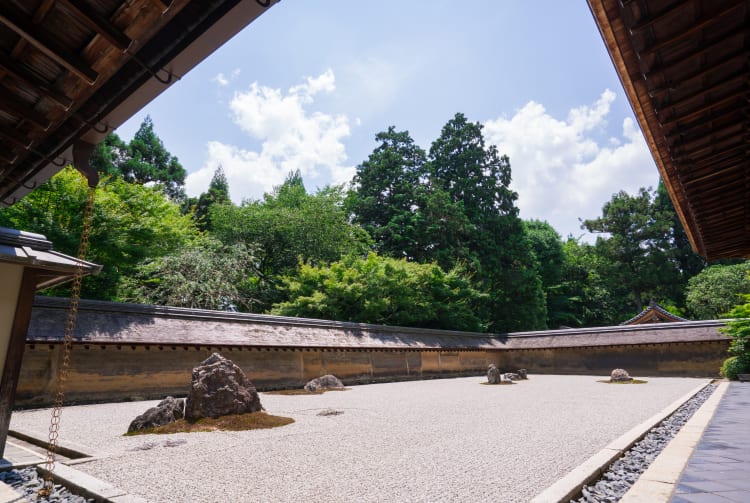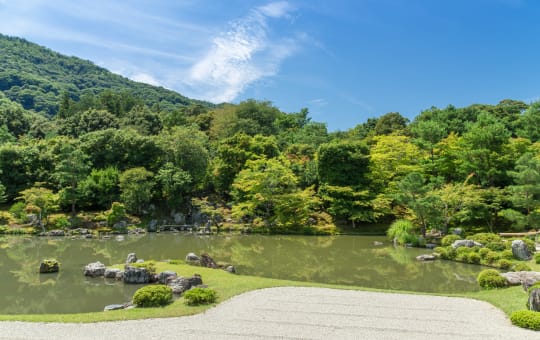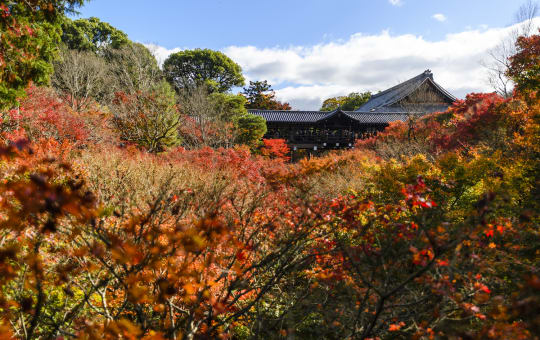Fifteen stones and white sand to express the world of Zen
Ryoanji Temple Rock Garden is one of Kyoto's most famous gardens. So famous, in fact, that the name has become synonymous with Japanese rock gardens worldwide. With its traditional architecture and gardens, Ryoanji is a UNESCO World Heritage Site, and a must-visit for any visitor to Kyoto .
Don't Miss
- The stone basin on the north side of the priest's chambers
- A stroll around the temple grounds, gorgeous during the cherry blossom season
- Visiting right when it opens or just before closing, when there are few visitors
Quick Facts
Ryoanji has been featured in numerous books and photographs, and influenced the music of composer John Cage
The gate on the east side of the stone garden is reserved exclusively for imperial envoys, but was used by Queen Elizabeth during her 1975 visit
How to Get There
The temple can be accessed by train or bus.
Ryoanji is a 10-minute walk north from Ryoan-ji Station on the Keifuku Kitano Line. Alternatively, take the #59 bus from Sanjo Keihan Station to the Ryoan-ji-mae bus stop, right in front of the temple. There are one- and two-day passes available that offer unlimited bus and subway rides within the city.

A quiet sanctuary for aristocrats
The origins and creator of the rock garden are a mystery, but the temple itself was originally built as a villa for the lord of the aristocratic Tokudaiji family. It was then passed on to Hosokawa Katsumoto, a deputy of the Shogun, in 1450, who invited the priest Giten Genso to transform it into a Zen temple.
This internationally famous rock garden was said to be created at the end of Muromachi Period (around 1500), by a highly respected Zen monk, Tokuho Zenketsu.


An entire universe set in sand and stone
Featuring a deceptively simple layout of fifteen stones of various sizes set atop white sand in a space of about 250 square meters, the meaning of the garden has been a riddle since its conception.
One theory is that it expresses islets in an ocean, or mountains in a sea of clouds. Others think it represents a tigress and her cubs crossing a river. Like an intuitive Zen puzzle, it is up to the viewer's own interpretation and imagination.

A shift in worldview
The garden's fifteen stones are cleverly arranged so that there is always one rock that is hidden from view, regardless of where the viewer stands. This is a reference to the Asian concept of fifteen as the number of perfection. No person is perfect, so we are unable to see all the stones due to our limited perspective.
A deep and clever verbal pun
A unique stone wash basin (called a "tsukubai") can be found in the small garden at the back of the priest's chambers. It was placed for visitors to cleanse their hands before entering the tea ceremony room.
The round basin is made to look like an old Japanese coin, with four characters written along the side, which mean nothing when read alone. However, combining each of them to the square at the center (which is the shape for a Japanese character meaning “mouth”), the four characters' meaning shifts to form the idea that “one knows that they have just what they need.”
Avoiding the crowds
If you want to enjoy a quiet moment of meditation in the garden, arrive when it opens in the morning, since large numbers of tourists flock here during the day. After your contemplation, enjoy a stroll through the large traditional gardens or even stop by Seigenin on the temple grounds, to savor a purifying meal of Kyoto-style tofu.

























































